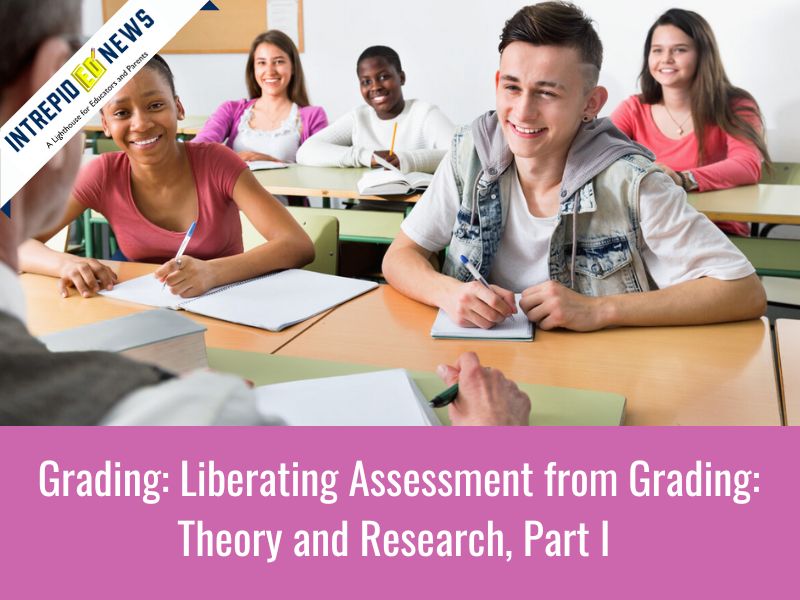Grading: Liberating Assessment from Grading: Theory and Research, Part I
This article is republished with permission from IntrepidEd News
Jared Colley
Those who choose education as their profession must answer one basic question about their purpose. How they answer this question will largely determine the direction of their career, how they go about their work, and how they judge their success. No other question about their role as an educator will be more important.
That one basic question is this:
Is my purpose to select talent, or is it to develop talent?
Thomas Guskey, 2015
At my school one of our norms is to start with questions, whether that be in a meeting, a class with students, or a new project we plan to start. But before we ask ourselves how we might liberate assessment practice from the specter of the grade, consider Thomas Guskey’s advice from On Your Mark: Challenging the Conventions of Grading and Reporting:
“Clarifying the purpose of grades… always must come first. All related changes in policy and practice can then be guided by that agreed-upon purpose statement.”
Thomas Guskey. On Your Mark: Challenging the Conventions of Grading and Reporting, 2015
If our methods are always shaped, first and foremost, by purpose, I suggest we start with the following question:
1. As Guskey puts it, is the purpose of education to select and sort talent, or is the purpose to develop talent in each and every learner?
Every time I’ve asked this question in workshops and conversations, a consensus quickly coalesces around the latter option. Teachers seem to agree: Of course, the purpose is to develop skills and capacities in every student we encounter! This means we need to think about education from what philosopher, Martha Nussbaum, calls a “Capabilities Approach” to human development where every student is treated as “as an end, asking not just about the total or average well-being [among students] but about the opportunities available to each [student]” (Creating Capabilities: The Human Development Approach, 2011).
This leads us to our current predicament: Grades, whether they be numbers or letters, were never historically intended to serve our agreed-upon purpose. Thomas Guskey makes clear that when defining the purpose for grading and reporting, we must make explicit for whom the report is intended — Who is our audience? A claim I’d like to make is that schools themselves were the original intended audience for grades in order for institutions to have an idea of the “total or average well-being” of their student body for purposes of sorting and selecting. Assessment, on the other hand, is intended for the learner with a “Capabilities Approach” in mind. To disentangle these contradictory reasons for grading and assessment we should ask the following:
2. If the purpose is to develop student talent, what are the optimal conditions for making sure our practices match the purpose?
When we talk about the optimal conditions for achieving our purpose as educators, disagreement is inevitable because “the grammar of schooling” from previous centuries is so deeply ingrained in all of us — parents and other stakeholders included. As David Tyack and Larry Cuban describe it, “During the last century, there has been much continuity in the structure, rules, and practices that organize the work of instruction. These organizational regularities, the grammar of schooling include such familiar practices as the age-grading of students, the division of knowledge into separate subjects, and the self-contained classroom with one teacher” (Tinkering Toward Utopia: A Century of Public School Reform, 1995). Joe Feldman cites Tyack and Cuban to point out that percentage and letter grades and how we compute them (using averages, etc.) are part of the “universal grammar” of traditional schooling as well (Grading for Equity: What It Is, Why It Matters, & How It Can Transform Schools and Classrooms, 2019).
Taking the metaphor literally, as a former writing instructor I always stressed to students that the rules of grammar are not rules per se but guidelines for helping one achieve their purpose, which in this case is to communicate clearly and effectively to an authentic audience. So to restate my claim differently, I argue that the purpose of grades is to select and sort learners, while the purpose of assessment is to develop capacities in each and every student.
Many of the authors cited support this claim with clear historical evidence. Joe Feldman writes, “Teachers have always given feedback to students about their learning, all the way back to Socrates and his pupil Plato. But the introduction of our current grading system is a relatively recent phenomenon, borne out of a particular American political, economic, and social context.” He goes on to say that “With compulsory education laws, larger schools, and the emphasis on efficiency, schools had to develop more succinct and simplified descriptions of student progress… Letter grades (A-F) had already been in place in some colleges and universities since the early 1900s to signify a student’s achievement in a course relative to others in the course — called ‘norm-referenced grading’” (2019). Guskey also emphasizes that “grades are meant to discriminate among students and to identify differences in their performance… [what’s] commonly referred to as the normative basis for grading.” With this purpose in mind, “grades have served well the sorting and selecting purposes of schools. Historically, schools have functioned to identify, and in some cases accentuate, the differences among students” for purposes of determining who should go to college versus who should learn the minimal amount needed to gain employment in an industrial society (2015).
Our problem is that the world has changed and our beliefs and values, as educators, have transformed as well. Grading and assessment practices, unfortunately, have remained the same — practices borne out of “a conviction that children had different abilities, interests, and destinies in life… [which caused schools] to treat [students] differently… They gave different labels to students who did not fit their definition of ‘normal,’ and they created tracks and niches for them. Progress to these experts meant a place for every child and every child in his or her place” (Tyack & Cuban, 1995). I believe our call as educators is not to determine and make sure that each student is in her right place but to liberate each student by developing capabilities. “What are capabilities?” asks Martha Nussbaum. “They are the answers to the question, ‘What is this person able to do and to be?’” She identifies capabilities as a person’s “substantial freedoms” — what Jacques Ranciere describes as the idea “that every common person might conceive his human dignity, take the measure of his intellectual capacity, and decide how to use it” (The Ignorant Schoolmaster, 1991).
Like Ranciere, I believe that all people have the capacity to be intelligent and therefore have the capacity to learn anything. This is not an outcome we are trying to reach: This is a radical axiomatic starting point that should shape our approach to grading and assessment. Grading, as we currently practice it, is about selecting and sorting each person and therefore limits a learner’s freedom and choice. Assessment, as I conceive it, attends to the development of every individual to build competency and thereby liberates a person to do what they desire with no predetermined destination in mind.
Jared’s conversation continues tomorrow with Part II, which will transform the theory and research of this piece into specific practical steps any school or teacher can take to implement a system that separates assessment from grading.


















Add comment